Abstract
The percutaneous transhepatic portal vein catheterization (PTP) with selective obliteration of the coronary vein and/or the short gastric veins in treating bleeding esophageal varices was introduced in 1974. In order to prevent recanalization of the vessels Bucrylate (isobutyl-2-cyano-acrylate) has been used in 43 patients 55 times during a period of 34 months (October 1975 to July 1978). The obliterative treatment was followed by rebleeding in 35% of the cases and continued bleeding occurred in two patients. Fourteen patients were treated on 16 occasions during acute bleedings, and five of these (36%) died within two months from a portal vein thrombosis caused by the obliterative procedure. Because of these findings PTP with obliteration of the veins feeding the esophageal varices is not recommended as an elective way of treatment. It should only be used in the acute bleeding patient when transesophageal sclerosering therapy, continuous vasopressin infusion and balloon tamponade have failed. Fifty-six per cent of the patients acutely treated stopped bleeding for more than one week, thus avoiding an emergency shunt or devascularization operation which are associated with a high mortality rate.
Full text
PDF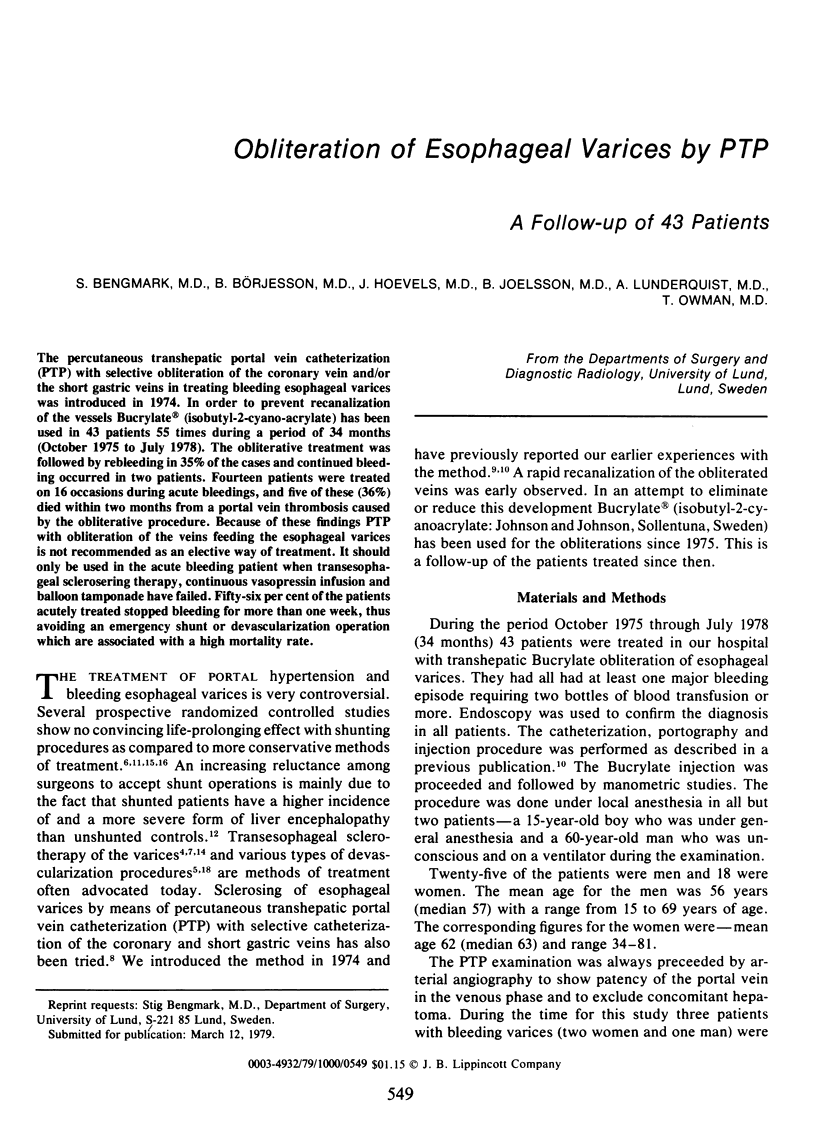

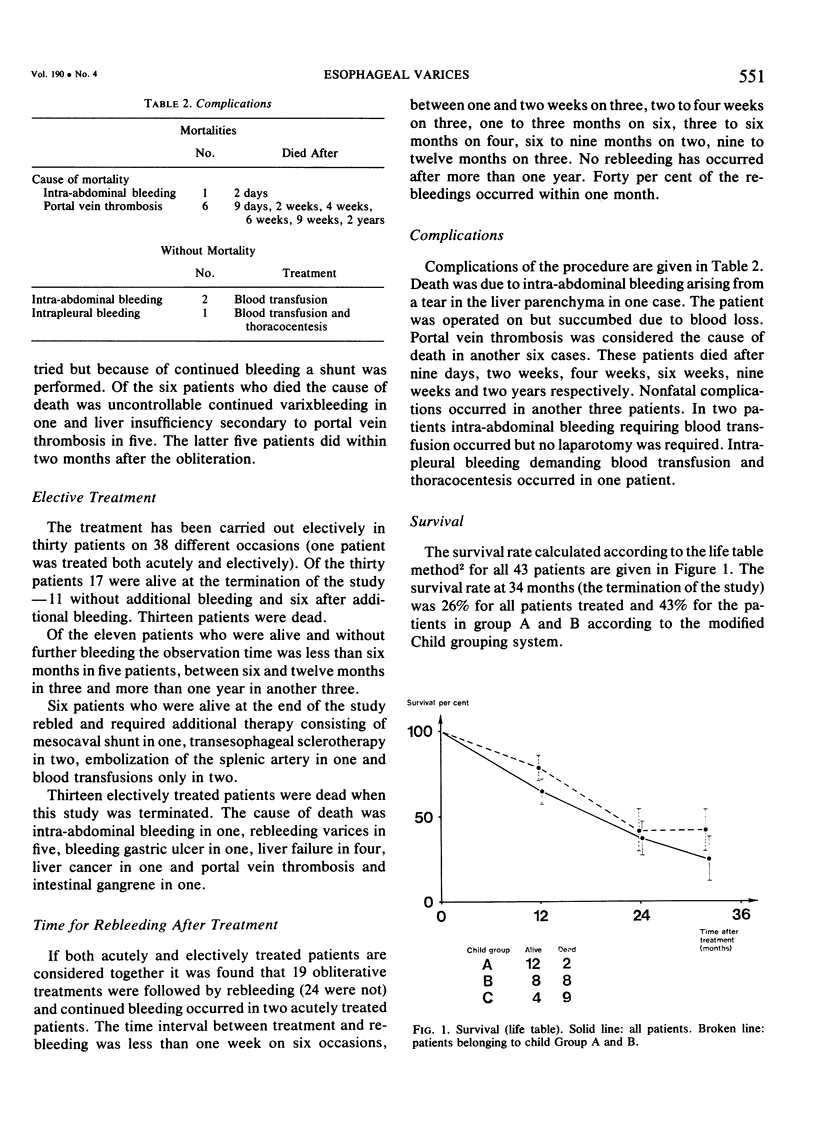
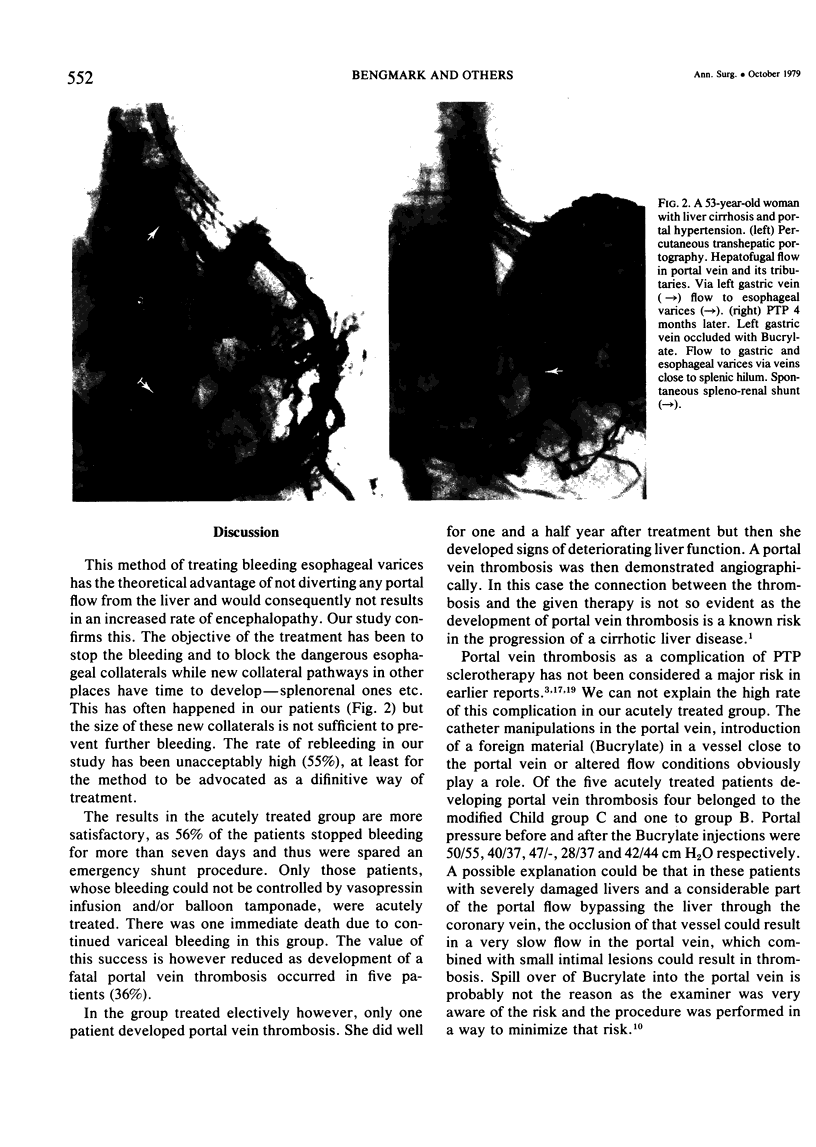
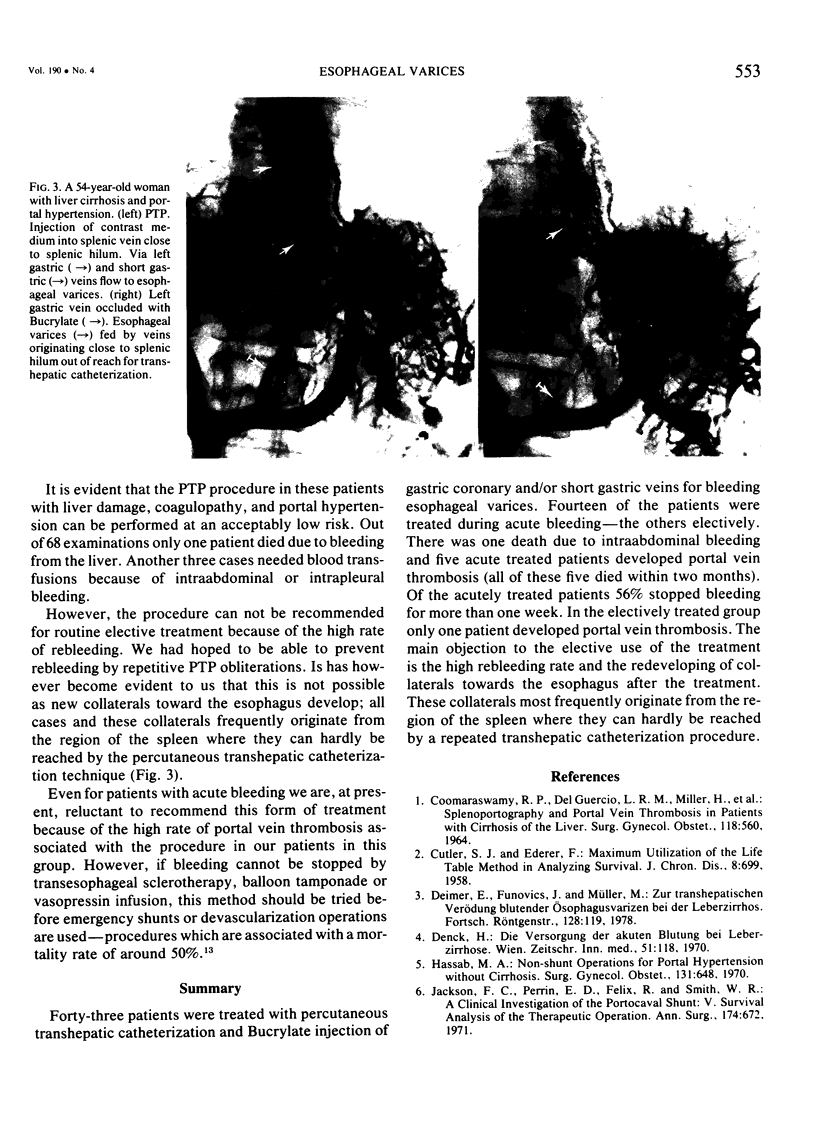
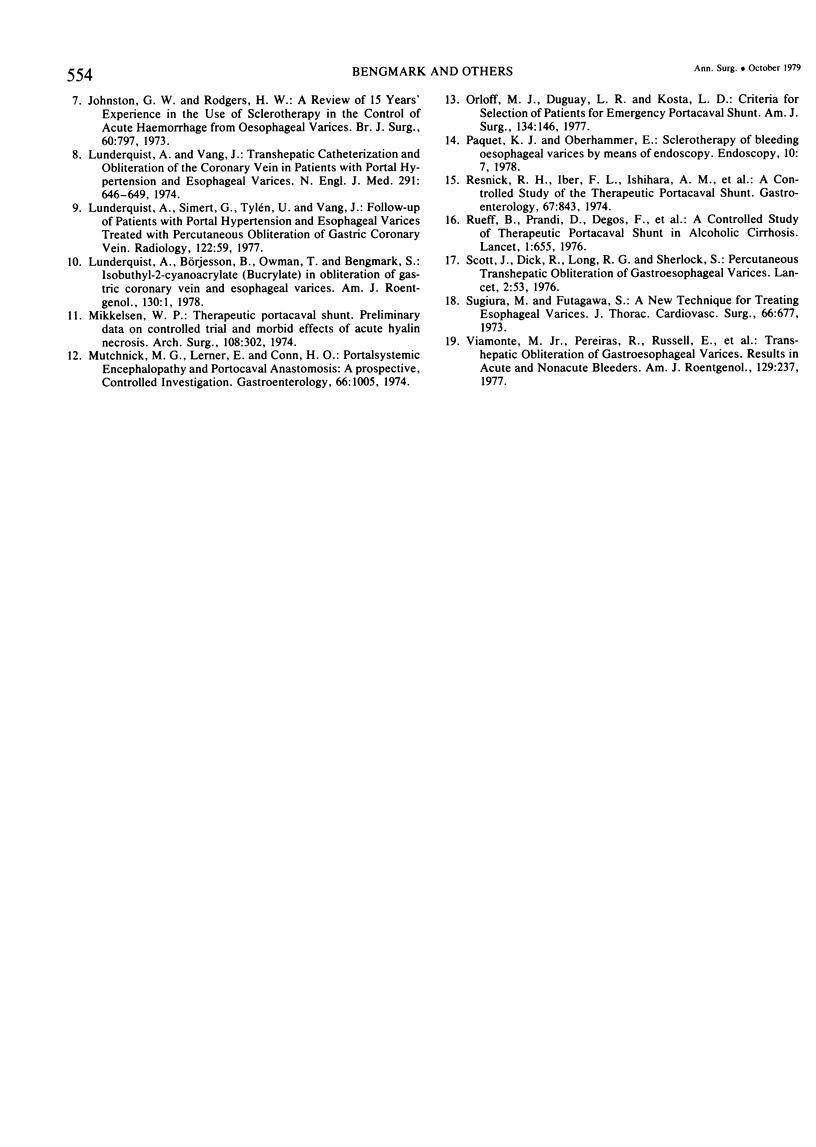
Images in this article
Selected References
These references are in PubMed. This may not be the complete list of references from this article.
- COOMARASWAMY R. P., DELGUERCIO L. R., MILLER H., STATE D., ELKIN M. SPLENOPORTOGRAPHY AND PORTAL VEIN THROMBOSIS IN PATIENTS WITH CIRRHOSIS OF THE LIVER. Surg Gynecol Obstet. 1964 Mar;118:560–566. [PubMed] [Google Scholar]
- CUTLER S. J., EDERER F. Maximum utilization of the life table method in analyzing survival. J Chronic Dis. 1958 Dec;8(6):699–712. doi: 10.1016/0021-9681(58)90126-7. [DOI] [PubMed] [Google Scholar]
- Deimer E., Funovics J., Müller M. Zur transhepatischen Verödung blutender Osophagusvarizen bei der Leberzirrhose. Rofo. 1978 Feb;128(2):119–124. doi: 10.1055/s-0029-1230806. [DOI] [PubMed] [Google Scholar]
- Denck H. Die Versorgung der akuten Blutung bei Leberzirrhose. Wien Z Inn Med. 1970;51(3):118–120. [PubMed] [Google Scholar]
- Hassab M. A. Nonshunt operations in portal hypertension without cirrhosis. Surg Gynecol Obstet. 1970 Oct;131(4):648–654. [PubMed] [Google Scholar]
- Jackson F. C., Perrin E. B., Felix W. R., Smith A. G. A clinical investigation of the portacaval shunt. V. Survival analysis of the therapeutic operation. Ann Surg. 1971 Oct;174(4):672–701. doi: 10.1097/00000658-197110000-00012. [DOI] [PMC free article] [PubMed] [Google Scholar]
- Johnston G. W., Rodgers H. W. A review of 15 years' experience in the use of sclerotherapy in the control of acute haemorrhage from oesophageal varices. Br J Surg. 1973 Oct;60(10):797–800. doi: 10.1002/bjs.1800601011. [DOI] [PubMed] [Google Scholar]
- Lunderquist A., Börjesson B., Owman T., Bengmark S. Isobutyl 2-cyanoacrylate (bucrylate) in obliteration of gastric coronary vein and esophageal varices. AJR Am J Roentgenol. 1978 Jan;130(1):1–6. doi: 10.2214/ajr.130.1.1. [DOI] [PubMed] [Google Scholar]
- Lunderquist A., Simert G., Tylén U., Vang J. Follow-up of patients with portal hypertension and esophageal varices treated with percutaneous obliteration of gastric coronary vein. Radiology. 1977 Jan;122(1):59–63. doi: 10.1148/122.1.59. [DOI] [PubMed] [Google Scholar]
- Lunderquist A., Vang J. Transhepatic catheterization and obliteration of the coronary vein in patients with portal hypertension and esophageal varices. N Engl J Med. 1974 Sep 26;291(13):646–649. doi: 10.1056/NEJM197409262911303. [DOI] [PubMed] [Google Scholar]
- Mikkelsen W. P. Therapeutic portacaval shunt. Preliminary data on controlled trial and morbid effects of acute hyaline necrosis. Arch Surg. 1974 Mar;108(3):302–305. doi: 10.1001/archsurg.1974.01350270036007. [DOI] [PubMed] [Google Scholar]
- Mutchnick M. G., Lerner E., Conn H. O. Portal-systemic encephalopathy and portacaval anastomosis: a prospective, controlled investigation. Gastroenterology. 1974 May;66(5):1005–1019. [PubMed] [Google Scholar]
- Orloff M. J., Duguay L. R., Kosta L. D. Criteria for selection of patients for emergency portacaval shunt. Am J Surg. 1977 Jul;134(1):146–152. doi: 10.1016/0002-9610(77)90298-7. [DOI] [PubMed] [Google Scholar]
- Paquet K. J., Oberhammer E. Sclerotherapy of bleeding oesophageal varices by means of endoscopy. Endoscopy. 1978 Feb;10(1):7–12. doi: 10.1055/s-0028-1098252. [DOI] [PubMed] [Google Scholar]
- Resnick R. H., Iber F. L., Ishihara A. M., Chalmers T. C., Zimmerman H. A controlled study of the therapeutic portacaval shunt. Gastroenterology. 1974 Nov;67(5):843–857. [PubMed] [Google Scholar]
- Rueff B., Prandi D., Degos F., Sicot J., Degos J. D., Sicot C., Maillard J. N., Fauvert R., Benhamou J. P. A controlled study of therapeutic portacaval shunt in alcoholic cirrhosis. Lancet. 1976 Mar 27;1(7961):655–659. doi: 10.1016/s0140-6736(76)92775-6. [DOI] [PubMed] [Google Scholar]
- Scott J., Dick R., Long R. G., Sherlock S. Percutaneous transhepatic obliteration of gastro-oesophageal varices. Lancet. 1976 Jul 10;2(7976):53–55. doi: 10.1016/s0140-6736(76)92281-9. [DOI] [PubMed] [Google Scholar]
- Sugiura M., Futagawa S. A new technique for treating esophageal varices. J Thorac Cardiovasc Surg. 1973 Nov;66(5):677–685. [PubMed] [Google Scholar]
- Viamonte M., Jr, Pereiras R., Russell E., Le Page J., Hutson D. Transhepatic obliteration of gastroesophageal varices: results in acute and nonacute bleeders. AJR Am J Roentgenol. 1977 Aug;129(2):237–241. doi: 10.2214/ajr.129.2.237. [DOI] [PubMed] [Google Scholar]




